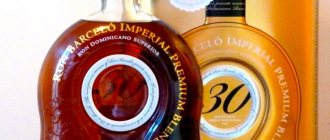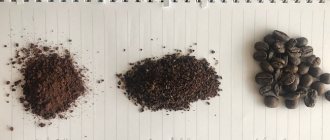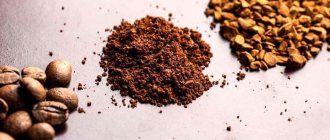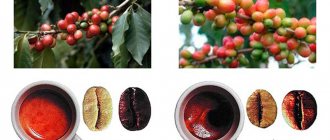In Turkey, coffee drink lovers treat the intricacies of selecting high-quality coffee and preparing it in the classic way with particular scrupulousness.
Coffee brewed in a cezve helps to reveal the exquisite aroma of the beans and enjoy their unique taste, but in order to choose natural coffee beans and not purchase a fake, the gourmet will have to become familiar with the selection criteria and the best varieties .
Page navigation:
Criteria for choosing Turkish coffee
Variety
The main selection criterion on which the taste of the prepared drink depends. Popular types of raw materials from which Turkish coffee is brewed are :
- Arabica is considered an elite variety, has many shades of taste and aroma, and contains a small amount of caffeine. To prepare an aromatic drink in Turk, it is better to choose Arabica. This variety has a rich aroma and taste, light sourness and a pleasant aftertaste;
- Robusta is a variety characterized by a rough taste, high caffeine content and low cost due to lower cultivation costs. Espresso lovers should give preference to robusta – this drink will be strong, with bitterness and creamy foam.
Important! If desired, robusta beans can be mixed with Arabica in any proportions, resulting in a unique drink with interesting taste and aromatic properties.
Region of growth
The best taste of an invigorating drink is determined by the area in which the raw materials were grown. Today, the largest supplier of beans is Brazil , where Arabica coffee with a rich chocolate-nut aroma is obtained. Brazilian is distinguished by a slight bitterness and a smooth, velvety texture, for which it is especially appreciated by gourmets.
In addition to Brazil, there are also coffee plantations in:
- Ethiopia - with a sour aftertaste and subtle aroma of wild berries;
- Indonesia - grains with a sweet nutty flavor, pronounced aroma with citrus notes;
- Kube - with a slight sourness, a pleasant sweetish aftertaste and bright flavor shades;
- Honduras – strong coffee with bitterness, soft floral taste and delicate sourness;
- India - you can detect chocolate notes in the taste of the prepared drink;
- Colombia - beans with a soft, balanced taste and fruity aroma;
- Kenya - the grains are slightly sour and have a pleasant currant flavor.
Grinding degree
You won’t be able to prepare a delicious drink in a Turk without properly grinding the beans. The grinding of coffee beans can be :
- coarse - large particles with a diameter of up to 1 mm, which clearly reveal their taste and aromatic properties when brewed;
- medium – a common grind, most often used for preparing in a coffee machine or brewing it in a cup;
- thin – particle size up to 0.3 mm, which complicates the filtration process;
- ultra-fine – used to prepare real Turkish coffee. The fraction size is only 0.1 mm;
- powdery - the consistency resembles flour, which makes the drink thicker.
Attention! To prepare in a Turk, you need finely ground and powdered coffee, which will allow you to get an aromatic and rich drink in 5-7 minutes.
Roasting
The degree of heat treatment also affects the taste. There are only five types of roasting :
- English - minimal processing, in which the grains simmer for only a few minutes;
- American – light roasting, preserving the herbal aroma of coffee beans;
- urban – medium degree of roasting, giving the beans a pronounced aftertaste;
- Viennese - long-term heat treatment, during which the beans acquire a black tint and a bitter taste;
- Spanish – the maximum degree of roasting, giving the beans a rich, burnt taste.
When buying coffee, you should look at the labels on the packaging indicating the degree of roasting of the beans.
For this, many manufacturers use a scale from 1 to 5 .
The lowest number indicates a light roast, while the number 5 indicates a deep roast.
How does grinding affect the taste of coffee?
In order to understand how the degree of grinding affects the taste of coffee, let’s take a short excursion “into the depths of the process.”
Coffee, at its core, is a herbal decoction or infusion, saturated with aromatic and flavor fractions of coffee beans. In the process of preparing coffee by any of the known methods, the process of transfer of aromatic and flavoring substances from the beans into water occurs. This is called extraction. The rate of transition of various substances from grains to water is not the same. Acids are transferred the fastest, tannins and minerals are the slowest. Aromatic fractions tend to disintegrate quickly when exposed to excessive heat. What follows from this?
- If the extraction time is too short, the coffee will be sour and weak.
- If you overstay the process, the drink will turn out to be overly bitter and completely unflavoured.
Optimal extraction times for various coffee preparation methods have been experimentally determined. In a French press, coffee is prepared in 3-4 minutes, in a coffee machine – 15-25 seconds. But all these recommendations only apply if you choose the right grind.
- If you take finely ground coffee and steep it in a French coffee maker for 4 minutes, the result will be too bitter due to over-extraction.
- If you load coarsely ground coffee into the coffee machine, then in 20 or even 25 seconds you will only get a sour and cloudy drink due to insufficient extraction.
The choice of coffee grind for each recipe and preparation method has a decisive influence on the taste of the drink. Optimal extraction requires a certain size of coffee particles. If you take coffee that is more or less ground than you need, you will get a drink of worse quality.
Signs of quality grains
To purchase high-quality coffee beans, you first need to pay attention to their appearance. The beans should be whole, approximately the same in size and shape, and exude a pleasant aroma . If there is an unpleasant rancid odor, you should not buy grains.
It is impossible to determine the quality of coffee beans in opaque packaging, so experts recommend buying coffee in specialized stores , where the buyer will have the opportunity to examine the beans and ask to grind them.
By the way! Having made a choice in favor of beans in a package, you need to ensure that it is hermetically sealed and not damaged.
Features from different countries
An important role in choosing Turkish coffee is played not by the brand or the country where the product was packaged, but by the region in which the coffee trees grew .
The choice of grains will depend on the individual preferences of the consumer :
- if you want a strong drink with a bitter taste, you should choose coffee from Honduras or Indonesia;
- for a charge of vivacity for the whole day, Brazilian, characterized by richness and strength, is perfect;
- Delicate taste with fruity notes will be provided by coffee beans from Kenya or Ethiopia.
Which one is better to choose?
Manufacturers offer 3 types :
- In grains - the traditional form, the most convenient for storage. Grain can be stored for a long time without fear that it will lose its smell or taste. In addition, a drink made from freshly ground coffee beans is much tastier than one brewed from vacuum-packed ground coffee.
- Powder – crushed coffee beans for brewing in a Turk, coffee maker or coffee machine. From the point of view of storage possibilities, ground is inferior to grain, since it quickly loses its aromatic qualities, absorbing foreign odors.
- Capsule – the product is ground coffee packed in a disposable vacuum capsule. Each capsule contains a portion of an aromatic drink of a certain type and degree of roasting, however, this option is intended for preparation in a capsule coffee machine.
For your information! Coffee capsules can also be brewed using a Turk. To do this, you just need to open the capsule and pour its contents into the cezve, then prepare the drink in the usual way.
The basic rule for choosing grinding
If you find it difficult to determine what grind you need, then follow the golden rule. The shorter the interaction time between ground coffee and water, the finer grind you will need. And vice versa: the longer the brewing or infusion process takes place, the larger the grain particles should be.
Table. How to choose coffee grind?
| Cooking method | Coffee recipe | Suitable grind size |
| Turk | Oriental coffee | Ultra-fine, feels like powder |
| Coffee machine | Espresso and drinks based on it | Thin, feels like extra salt |
| Geyser, carob and drip coffee maker | Black coffee | Medium, universal, feels like river sand or fine sugar |
| Chemex, pour over, aeropress | Alternative brewing | Medium coarse, feels like regular table salt or brown sugar. |
| Cupping | Coffee in a cup | Large, to the touch - slightly larger than ordinary salt, large fractions may appear, |
| French press | Coffee by infusion method | Very coarse grind, feels like pickling, coarse salt. |
Popular brands
To prepare Turkish coffee, true connoisseurs of invigorating drinks use exclusively grain varieties from well-known manufacturers, known for the high quality of their products.
Consumers call the best brands :
- Paulig is a Finnish brand, popular in Russia and the Baltic states. The main feature is the combination of high quality Arabica and Robusta, so Paulig will definitely appeal to those who prefer classic coffee with a balanced taste, combining light sourness, slight bitterness and a sweet aftertaste.
- Jardin is one of the most purchased brands among Russians. It is relatively inexpensive, however, it belongs to the premium class. Jardin produces coffee beans with a distinct taste, in which notes of black currant and chocolate are felt. Coffee lovers like the drink for its lack of burnt smell, moderate strength and harmonious taste.
- Lavazza is real Italian coffee, officially certified organic and environmentally friendly. The drink, brewed in a Turk from freshly ground grains, is distinguished by its rich aristocratic taste, unique aroma and stable creamy foam. The manufacturer occupies a leading position in the market, which indicates the quality of its products and their safety.
- Kimbo is a Neapolitan convection roasted coffee, known in 50 countries around the world. The company works with Arabica and Robusta beans, producing original blends with a delicious taste. The Kimbo brand has received several international certificates confirming the technical excellence of production processes and the environmental friendliness of the product, which means it can be trusted.
- Molinari products occupy the premium segment of the coffee market, as they are distinguished by an ideal combination of elite varieties with an intense noble aroma, delicate texture and velvety taste. Roasting of beans and their packaging are carried out using high-tech equipment, so the beans retain their smell and taste longer.
- La genovese is Italian coffee beans, for the production of which air roasting is used, which allows you to preserve all the beneficial substances in the coffee beans. The manufacturer also took care of gourmets who prefer coffee with minimal caffeine content. Decaffeinato Macinato ground coffee was released especially for them.
- Carraro is coffee from an Italian manufacturer for preparing an aromatic drink in Turkey. To give an unusual taste, Carraro factory masters use 8 different varieties with bright chocolate and fruit notes. The line also includes coffee with a subtle aroma of Indian spices.
Grain or ground?
The very first question that may arise is what is better to brew in a Turkish coffee pot – ground coffee or beans. The confusion arises because many recipes say: take whole grain coffee or 5-7 grams of beans. But the beans themselves are not boiled, but bean coffee is called to distinguish it from instant coffee, which is the same as ground coffee. Soluble is also not used, even if it contains some grains ground into dust. That is, instant with the addition of natural ingredients does not need to be boiled; it is simply poured with hot water in a cup.
In Turks, only ground coffee is brewed.
The best varieties
Despite the strength of Robusta and its flavor and aromatic properties, when brewing coffee in Turkish, experts recommend that connoisseurs of coffee drinks choose 100% Arabica coffee, medium or lightly roasted .
The ranking of the best Arabica varieties looks like this:
- Bourbon is a coffee with a slight acidity and a bittersweet aftertaste.
- Maragodzhip – grains with a pronounced bitterness.
- Tarrazu is strong with hints of ripe pear and apricot.
- Mocha – gives a nutty-chocolate aftertaste without sourness.
- Carrar – medium strength with a sweet aftertaste.










